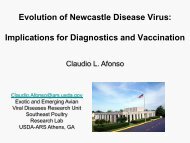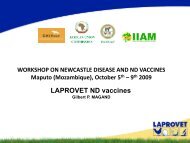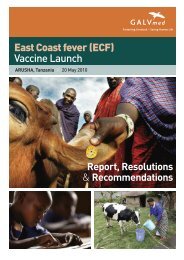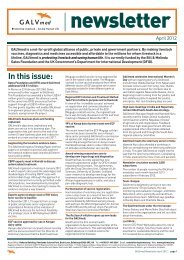A Path to Prosperity New Directions for African Livestock
GALVmed Impetus Strategy Paper
GALVmed Impetus Strategy Paper
- No tags were found...
You also want an ePaper? Increase the reach of your titles
YUMPU automatically turns print PDFs into web optimized ePapers that Google loves.
2 Overview<br />
2.1 Agriculture and Food Security<br />
in Africa<br />
Agriculture is vital <strong>for</strong> promoting growth and<br />
reducing poverty in Africa and essential <strong>to</strong> the<br />
achievement of Millennium Development Goals<br />
(MDG). Agriculture currently supports the livelihoods<br />
of 80% of the <strong>African</strong> population, provides<br />
employment <strong>for</strong> about 60% of the economicallyactive<br />
population, and employment <strong>for</strong> about 70<br />
% of the poorest people on the continent 2 .<br />
Development is vital. The human population of<br />
Sub-Saharan Africa (SSA) is approaching 800 million<br />
people 3 and is growing at around 2.2% per annum,<br />
compared <strong>to</strong> the global average of 1%. This fastgrowing<br />
population is becoming increasingly urban,<br />
with the overall share of the population living in<br />
urban areas growing by 1.5% per year; which means<br />
another 1.2 million people in cities next year. This<br />
percentage of urban growth is similar <strong>to</strong> other<br />
developing regions. However, the predicted GDP per<br />
capital growth rate <strong>for</strong> the next 20 years is far lower<br />
<strong>for</strong> SSA, at around 1.6%, compared <strong>to</strong> 4.7% <strong>for</strong> South<br />
Asia and 5.3% <strong>for</strong> East Asia and the Pacific 1 .<br />
Agricultural growth is a proven driver of poverty<br />
reduction. When agriculture stimulates growth in<br />
Africa, the growth is twice as effective in reducing<br />
poverty as growth based in other sec<strong>to</strong>rs. In China,<br />
agriculture-based growth is 3.5 times more effective<br />
in reducing poverty than growth based on other<br />
sec<strong>to</strong>rs. In Latin America, the effectiveness is 2.7<br />
times 4 . Agricultural growth also means greater food<br />
security. Sub-Saharan Africa currently has the<br />
highest proportion of undernourished people in the<br />
world, at 30 % of the population.<br />
At current rates, it is estimated that Africa will be<br />
unable <strong>to</strong> adequately feed half its population by<br />
2015 2 . Agricultural GDP per farmer has over the last<br />
two decades risen by 2% per annum in Asia, nearly<br />
3% in Latin America but less than 1% in Africa. In<br />
Africa farmers have been working harder and more<br />
people have taken up farming, but productivity has<br />
not increased. Most of the growth stems from<br />
increases in the land area under exploitation rather<br />
than from increases in productivity.<br />
Africa is endowed with a wide diversity of<br />
agro-ecological zones. These zones range from the<br />
heavy rain-<strong>for</strong>est vegetation with bi-annual rainfall<br />
<strong>to</strong> relatively sparse, dry and arid vegetation with low<br />
uni-modal rainfall. This diversity is a tremendous<br />
asset, but it also poses a substantial challenge <strong>for</strong><br />
<strong>African</strong> agricultural development.<br />
On the one hand, it creates a vast potential with<br />
respect <strong>to</strong> the mix of agricultural commodities<br />
and products which can be produced and marketed<br />
in domestic and external markets. On the other<br />
hand, the diversity implies that there are no universal<br />
solutions <strong>to</strong> agricultural development problems<br />
across the continent. Consequently, any interventions<br />
must be tailored <strong>to</strong> the particular conditions of the<br />
different agro-ecological zones and <strong>to</strong> prevailing<br />
socio-economic conditions of rural households<br />
within individual countries.<br />
Over the last three decades, increases in agricultural<br />
output in Africa have come largely through extending<br />
rain-fed crop cultivation, particularly food crops, on<br />
<strong>to</strong> more and more marginal soils and/or by reducing<br />
traditional fallow periods in cropping cycles.<br />
Under conditions of rapid human population<br />
growth, rural households have been <strong>for</strong>ced <strong>to</strong> adopt<br />
agricultural practices that guarantee their survival.<br />
Un<strong>for</strong>tunately, raising the productivity of crop<br />
enterprises through intensification per unit of land<br />
cultivated – i.e., through increasing crop yields per<br />
hectare – has not been adequately promoted as an<br />
important household food security strategy.<br />
Apart from commercial agriculture which covers a<br />
relatively small share of lives<strong>to</strong>ck crop production,<br />
the use of agricultural inputs – that is, improved<br />
seeds and breeds, animal health, inorganic fertilizers<br />
and pesticides – has been much lower in Africa than<br />
in other parts of the developing world. Inorganic<br />
fertilizer use is often less than 10kg per hectare.<br />
Use of agro-chemicals and/or integrated pest<br />
management techniques <strong>to</strong> deal with plant diseases<br />
and pests is still largely confined <strong>to</strong> export crops 2 .<br />
1 World Bank, World Development Indica<strong>to</strong>rs.<br />
The Impetus Strategy Paper I Page 9











